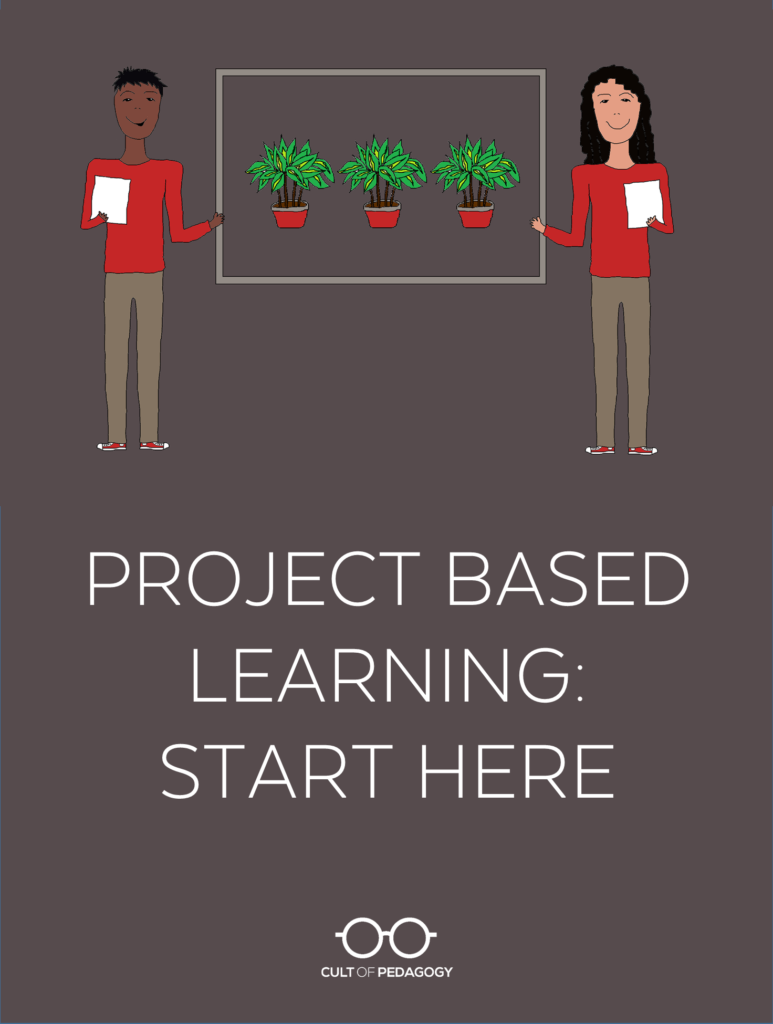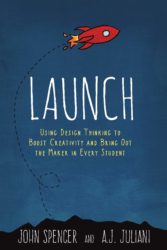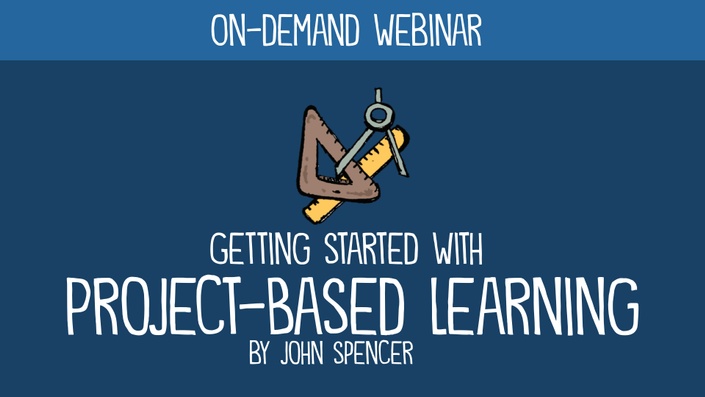Project Based Learning: Start Here

Despite the popularity of project based learning, a lot of teachers haven’t gotten around to trying it yet. You’ve been meaning to; you just haven’t had time to learn how. Or maybe you’re doing something you call project based learning, but you have a nagging feeling that you might not be doing it quite right.
If any of this sounds familiar, then this will help. One reason PBL might be hard for some teachers to start is that there’s just so much stuff out there about it. Who has time to wade through it all? To solve this problem, I went out in search of the clearest, most authoritative information on PBL and put together a collection of materials that will help you get your feet wet, plus links to more resources for when you’re ready to dig deeper.
What exactly IS project based learning?
The easiest way to explain PBL is to compare it to what we think of as “traditional” instruction: In a traditional classroom, we deliver content to students, give them opportunities to practice or apply what they learned, and eventually conduct a summative assessment—this could take the form of a test or it could be more of a performance assessment, like an essay, a speech, or a project of some kind. Careful, though: The “project” in many cases is often something like a poster that merely regurgitates the facts students were taught in the unit.
With project based learning, the content is baked inside of a long-term project, a real-world problem students need to solve in a creative and authentic way. In the process of solving the problem, students also meet required standards, but this work is integrated into the project, not separate from it.
Take the study of viruses, for example. A PBL project might ask students to educate their peers on the best ways to prevent the spread of viruses in school. To do this, they would need to study microbiology to understand how viruses work, research prevention tools, then use their writing and speaking skills to determine the most effective means to convince their peers to change their habits; this may come in the form of a video or poster series.
In this Edutopia video, we get a good overview of how PBL is different from the kind of instruction most of us are used to.
This video is part of a series called “5 Keys to Rigorous Project-Based Learning.” To watch the whole 5-part series, click here.
Why is everyone going crazy for PBL?
Student Engagement
For as long as school has been around, students have asked, “When am I ever going to use this stuff in real life?” And they have a point: Because our default setting is to teach our material out of context, students rarely see its relevance. Even if we are able to design a project that has them apply their knowledge in real-world ways, the project is often hypothetical—students know it’s still a school assignment, so they aren’t as engaged as they would be if it were real. Project based learning doesn’t just add a dose of relevance to the standard model; it builds the learning within a relevant context from the very start, so students are naturally more engaged.
21st Century Skills
Now that technology has made it easy to find any fact in a matter of seconds, the ability to regurgitate information is no longer valued the way it once was. It is becoming abundantly clear to educators and employers that students need to be able to do more than spit out facts. In a 2015 survey conducted by the National Association of Colleges and Employers, employers listed the skills they valued the most in new hires. In the top 10 were qualities like the ability to work on a team, problem-solving skills, written and verbal communication skills, and initiative. All of these are developed beautifully in project based learning.
Improved Academic Performance
The research on project based learning tells us that it closes the achievement gap for underserved populations, improves understanding and retention of content, and increases motivation for all students. For more information on these studies, see the Buck Institute’s Research Summary on the Benefits of PBL.
Okay, but what does it really look like in real life?
To really understand project based learning, you need to see it in action. Here are three examples.
Media Saves the Beach
When California cut its budget for water quality testing, these San Diego high school students were charged with figuring out how to test the water quality on their own, then educate the public about ways they could protect and improve water quality in their daily lives. This project engaged student learning in two content areas: science knowledge was required to study the problem and develop solutions, and English language arts skills were needed to effectively communicate their ideas to the public.
Schenk Courtyard Project
Students at Schenk Elementary School were asked to redesign an underutilized courtyard space on the school campus. They drafted, revised, and presented their ideas in formal presentations to their classmates. They then met with architects, who shared their own plans and took student suggestions. I thought the project could be made more rigorous with the addition of budgeting, having students research the material and labor costs for their ideas and determine what would fit within the school’s budget, but even without that, the level of student engagement is pretty fantastic.
Hydroponics and World Hunger
In this TeachThought podcast, 4th grade teacher Nan Arant describes how her students worked to develop a solution to world hunger by studying alternative ways to grow plants; specifically, hydroponics and aquaponics. She also talks about how discovering PBL has changed the way she feels about teaching.
More Examples
To see other project based units, take a look at these resources:
- The Buck Institute’s Project Search page allows you to browse hundreds of projects, and you can narrow your search by content area and grade level.
- The projects page of High Tech High is a collection of student-completed projects. These also include written reflections from the teachers who taught the units.
- TeachThought keeps a long list of ideas for project based learning you can explore for inspiration.
How do I plan a project based unit?
Although a single, authoritative set of step-by-step instructions isn’t easy to find, these two articles describe processes that can help a beginner get started. They have some differences, so I would advise you to read through both and decide which one sounds right for you:
Problem-Based Learning: Six Steps to Design, Implement, and Assess, Vincent R. Genareo PhD and Renee Lyons, Faculty Focus
Practical PBL Series: Design an Instructional Unit in Seven Phases, Amber Graeber, Edutopia
What’s the difference between project-based learning and problem-based learning?
The short answer is that they are more or less the same, although it could be argued that there are fine points that make them different. In this 2015 Edutopia post, Buck Institute editor-in-chief John Larmer lists a number of terms that are often used interchangeably with project based learning, including inquiry-based learning, design-based learning, and case-based learning, and he explains the difference.
How do I handle grading with PBL?
Take a look at Edutopia’s collection of resources on assessment in project based learning.
Where can I go to keep learning?
Once you’re ready to really dig into the finer points of PBL, head to one of these sites. Each has a solid collection of well-researched resources that can teach you how to implement PBL and inspire you to make it happen in your classroom.
Webinar: Getting Started with Project-Based Learning
This free 30-minute, on-demand webinar tackles the seven most common PBL questions and includes a PBL toolbox of resources and six sample units. Learn more here.
The Buck Institute for Education (BIE)
It seems that every PBL trail eventually ends at BIE, an organization that has led the charge toward project based learning for 25 years. Here’s how they describe their mission: “Our highest priority is to help teachers prepare students for successful lives. We do this by showing teachers how to use Project Based Learning in all grade levels and subject areas. As a mission-driven nonprofit organization, BIE creates, gathers, and shares high-quality PBL instructional practices and products and provides highly effective services to teachers, schools, and districts.” The site includes videos, planning forms, and recorded webinars that teach the finer points of PBL. It’s also worth your time to study their Gold Standard PBL model, which outlines the criteria for the most rigorous and effective project based learning, and to look at their wide range of professional development opportunities. Visit BIE here.
Edutopia
Although Edutopia doesn’t focus exclusively on PBL, they have built an extensive library of articles and videos on the topic. In fact, project based learning is one of Edutopia’s six core strategies, so they spend lots of time looking at it from different angles, providing tools to do it well, and profiling schools that are implementing it in exemplary ways. Start exploring Edutopia’s PBL collection now.
New Tech Network
New Tech is a network of around 175 U.S. and Australian schools whose curriculum is built primarily on project based learning. Nearly every video I’ve seen of PBL in action happens to be filmed at a New Tech school, and they’re all impressive. Visiting their site will give a PBL newbie lots of opportunities to see this practice in action. To learn more, visit their website, or watch a few videos showcasing the best projects New Tech students have done.
What if I want even more?
 If you’re on a roll, you might also want to check out A.J. Juliani and John Spencer’s new book, Launch: Using Design Thinking to Boost Creativity and Bring Out the Maker in Every Student. Although the book is not strictly about project based learning, it offers a flexible framework for learning experiences that PBL fits right into, and it will really get you excited about tapping into student creativity in your classroom.
If you’re on a roll, you might also want to check out A.J. Juliani and John Spencer’s new book, Launch: Using Design Thinking to Boost Creativity and Bring Out the Maker in Every Student. Although the book is not strictly about project based learning, it offers a flexible framework for learning experiences that PBL fits right into, and it will really get you excited about tapping into student creativity in your classroom.
So where will you start?
If this has inspired you to get started with project based learning, share your plans with us! In the comments below, talk about the project you’re hoping to start with. If you have questions, this is the place to ask them. The most important thing to do is just start—it absolutely WILL NOT be perfect the first time around, so get the first one going and learn from it. Then, instead of saying you still haven’t gotten around to trying PBL, you can officially call yourself an experienced PBL teacher. ♦
Join the Cult of Pedagogy mailing list and get weekly tips, tools, and inspiration—in quick, bite-sized packages—all geared toward making your teaching more effective and fun. You’ll get access to my members-only library of free downloadable resources, including my e-booklet, 20 Ways to Cut Your Grading Time in Half, which has helped thousands of teachers spend less time grading!
